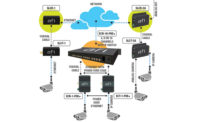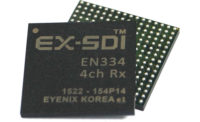Without question, the availability of high definition over coax (HDoC) technologies has had a significant impact on security integrators’ ongoing efforts to upgrade end users from traditional analog solutions. The ability to transmit HD signals over existing infrastructure has been a game-
changer, says Aaron Starr, CEO, North American Cable, West Chester, Pa.
“This is a once-in-a-lifetime opportunity to say to a property owner, ‘Hey, what if I can replace your camera and recorder to bring you HD quality and not have to charge you to run new cable?’ Those are words the property owners have waited a decade to hear,” he says.
While this is the primary draw for HDoC, the technology’s use is not limited to applications for upgrading end users to HD video using their existing coax infrastructure.
“There are some integrators who recommend and install HD over coax cameras and recorders in greenfield applications, but these installations are rare in comparison to new IP installations,” says Mark Espenschied, director of marketing, Digital Watchdog, Cerritos, Calif. “Billions of dollars of existing coaxial infrastructure remains in place in myriad vertical markets where swapping the recorders and cameras is a very attractive, convenient and rewarding option. That is where the biggest growth in HD over coax will come from.”
However, by several accounts, the percentage of HDoC deployments for new installations may not be so insignificant.
“According to feedback from our customers, we believe about 80 percent of HDoC customers will be upgrading a current system and the remaining 20 percent will be greenfield installations,” says Lou Bellock, product manager – hardware, Hikvision USA, City of Industry, Calif.
One of the main reasons for this phenomenon is installers’ familiarity with working with coax.
“From our experience, we have found HDoC mainly being used to upgrade existing analog systems to high definition. However, there are still installers who are more comfortable with coax and have been resistant toward transitioning over to IP,” says Corey Mutterperl, product manager, Speco Technologies, Amityville, N.Y.
Comparing Cables
The decision whether to use HDoC or another technology for a new installation depends largely on the particular scenario. According to Jennifer Hackenburg, senior product manager, Dahua Technology USA, Irvine, Calif., these are the general considerations to take into account when weighing the various infrastructure options.
Fiber: Ideal for network applications where longer runs are required (up to 1,000 meters) due to the camera being located far from the headend device. Fiber cable is more expensive than UTP and coax cables but fewer repeaters are required so longer distances can be achieved.
HD over Coax: Good for longer runs compared with UTP (less versus fiber) without a mid-span (up to 800 meters at 720p or 500 meters at 4 megapixel with HDCVI). RG59 coax cable is more expensive than UTP, but less than fiber. If it’s a retrofit, HD over coax is more cost-effective to continue using.
UTP: Only goes up to 100 meters without repeaters but is less expensive than RG59 coax and fiber. Since CAT5E/CAT6 is the least expensive cable, even if HD over coax technology will be used, the majority of new installations (90 percent to 95 percent) will use UTP.
No Networking Skills Required
The primary reasons installers tend to lean toward HDoC for new installations are its plug-and-play aspect and reliability.
“Nothing can go wrong (with coax). You have a camera, you have a connector, you have a cable between them and a recorder and you’re done,” says Robert Wegner, vice president of systems engineering and support, Hanwha Techwin America,
Ridgefield Park, N.J. “It is still extremely simple to utilize this kind of coax-based installation because very little can go wrong on it. It’s point-to-point and that’s why it’s still very popular with smaller installers.”
For installers who perform mainly smaller installations, the true popularity of HDoC lies in the simplicity of the deployment.
“They don’t have to train their staff very much. It’s very little IP involved. Of course, you can connect it to an IP camera, but it provides a very simple-to-use method of getting a system installed very quickly,” Wegner says. “It will work when you plug it in. When you power it up, it’s going to work. It’s not like IP where certain settings have to be done. It’s very simple and very reliable.”
The elimination of the need for networking knowledge is a key selling point for installers, but there are other considerations, as well.
“One of the benefits touted by HDoC is it does not have the complexity in setting up the network that IP video systems require. The counter to that claim is that an IP system offers far greater network management capabilities,” says Frank “Skip” Haight, vice president of marketing, Communication Networks (ComNet), Danbury, Conn.
Cost Analysis
When considering whether to deploy HDoC or another transport technology, it’s important to fully assess the cost of each potential solution while recognizing the applications for which each is most well-suited.
“Comparatively speaking, fiber cable is the most cost-effective cable. However, when the fiber transceivers are factored in, fiber is the least cost-effective solution,” Bellock says. “HDoC is the best value solution for customers who need to upgrade their image resolution capability, do not require enterprise network management, and are not budgeted for an IP solution.”
To help end users make the best choice for their particular situation, there are several factors security integrators must take into account.
“Specifying solutions using each type of infrastructure for comparison, and then factoring in future needs, IP-only features and end-user customer expectations can create an easy-to-understand picture an experienced integrator or architect can use to guide an end user customer through the decision-making process,” Espenschied says.
There is a point at which the economic benefit of HDoC decreases based on the size of the system. “HDoC is most cost-effective for systems 16 channels and below,” Starr says. “Beyond that the UTP systems become a better buy due to the high cost of labor in running point-to-point cable in HDoC camera systems. Fiber brings a cost savings in systems that run over very long runs, such as factories or between buildings.”
In the end, it’s up to the installation company to make the final decision. “It depends on the labor that’s involved with installations, so that’s really on dealers and installers,” Mutterperl says. “The ease of installation and competitive prices are all the reasons why HDoC has been so successful. Also, being that cable runs are the most labor-intensive part of any job, HDoC allows the existing coax infrastructure to stay in place while switching out the cameras and recorders to immediately upgrade to HD quality video.”
Growing Markets
With regard to applications for HD over coax, municipalities and corporations present tremendous potential for integrators. This is largely because they are choosing to retain their investments in coax infrastructure while adding or replacing cameras with HD analog cameras and recorders or encoders that can handle both existing and HD camera signals, says Digital Watchdog’s Mark Espenschied.
“A municipality, campus or multi-story building that is already wired with coax represents a significant resource that can yield new ROI,” he says. “HD over coax is not an also-ran. Research suggests this is a growing market segment due to years and years of history of CCTV being the only game in town, and those installations continue to be used and viable.”
Properly Accessorizing
One of the big issues to keep in mind when working with HDoC, particularly for larger systems, is the need for switching gear, matrixes and other accessories to work properly with the technology.
“While the cameras will work in standard analog mode, most likely when you go through a matrix you can’t use HD, because the matrix cannot manage the high frequencies needed to provide a 1080p picture. So accessories like baluns, fiber and media converters — all of those have to be up to standard in order to be used with HD over coax,” Wegner explains.
Unfortunately, he says, that is sometimes overlooked. “It’s great to replace a simple system — a recorder and 16 cameras. But if you have 50 cameras and a matrix involved, that may be a problem,” Wegner says. “At the moment, you have some video processing equipment that may be a problem because of the higher frequencies used with HD over coax products.”
More and more accessory companies are making devices that will work with the various HDoC standards, something that was rare just a few months ago, Wegner adds. “Now you can find these very easily. You can buy a balun if you want to utilize twisted pair to translate your AHD, CVI or TVI signal,” he says. “You can get them very cheaply, and now they work well where before they were limited so they couldn’t work correctly. Now they’re made for the high-frequency standard.”
For now, at least, HDoC isn’t going anywhere, and continued improvements may advance the technology’s use even farther.
“It’s still an industry that’s growing because there’s so much possibility out there and the price point is so low on those items that it makes sense,” Wegner says. “You’re going to see a lot of improvements.
Sorting the Standards
HD over coax is a catch-all for four technologies that enable the transmission of HD video signals over coaxial cable. These are: high-definition serial data interface (HD-SDI); HD composite video interface (HDCVI); HD transport video interface (HD-TVI); and analog HD (AHD). All are currently in use for video surveillance equipment and while some are more popular than others, there is no indication that one or more will emerge as an overarching, industry-wide HDoC standard.
The granddaddy of these is HD-SDI, which has fallen behind other standards in recent years.
“HD-SDI is an old standard that has been used by broadcasters for a long time. It’s actually one of my favorite standards because the picture is as good as anything,” says Hanwha Techwin America’s Robert Wegner. “Some companies, including us, tried to make products for the security industry but not very successfully because the products were too expensive. That’s when they looked to other standards.”
However, all of the standards are fairly solid, he adds.
“They all have advantages and disadvantages, but there’s very little difference. I would say if you put three monitors next to each other and one is running AHD, another is running CVI, and another is running TVI — and they’re all playing on the same field, say, 1080p at 30 frames a second — you’re probably not going to be able to see a difference,” Wegner says. “On paper, of course, they have differences, but they’re pretty good — they’re very similar.”
The decision of which of the standards to employ relies largely on what the manufacturer has decided to use in its products. And the capabilities of those products is as important as, if not more important than, the chosen standard itself, Wegner says.
“It’s really a preference. It’s a choice and it’s more about what comes before the standard that is connected to coax. I think that’s more important than the actual standard,” he says. ”We can already do four megapixel on AHD, and soon you’re going to see 4K on AHD. It’s coming, and it’s already out there.”
In many ways, manufacturers’ standard(s) of choice come down to licensing cost and complexity.
“To me, this goes to the ownership of the standards. I think that what we refer to as HD-Analog (AHD) is the least restrictive in terms of limiting use via the cost of licensing,” says Digital Watchdog’s Mark Espenschied. “The specs of the standards are similar and people seem to argue for their favorite. There is a little difference in the length of the run, but again, similar. I think what used to be a significant issue is now a generic issue with people expecting all three standards to be supported by the camera or DVR.”
At present, there are two standards that have risen to the top, believes North American Cable’s Aaron Starr.
“The most popular is TVI, second to that is CVI. There are two others, AHD and SDI, but these are not very popular and SDI has significant distance limitation for cable runs,” he says. “Although these standards are not interoperable, recorders are hitting the market now that can do two or more of these.”





